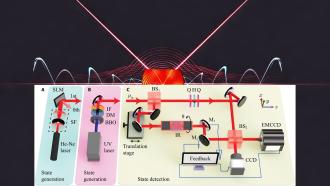
Looking up at the clear moonless sky gives one a glimpse of the breathtaking view presented by a part of our galaxy, the Milky Way, as a starry strip across the sky. Whether you are stargazing casually or observing with a pair of binoculars or a telescope, you are always in for a treat whenever you point your ‘eyes’ at the beautiful star clusters, nebulae and the dusty dark lanes. However, beyond the myriad stars and nebulae, exists a complex system of a star cluster near the massive black hole at the very centre of our galaxy. Most of these central ‘nuclear’ stars are old, but there are some young and luminous stars that appear to be distributed in a disc very close to the black hole. Unlike most other stars that are formed by dense clumps of molecular gas, these young stars are thought to have originated when the gas around the massive black hole fragmented to form locally dense regions. In this case, their orbits at formation would have been close to circular shape, inherited from the parent gas flow. But the young stars at the galactic center have orbits that are much more elongated or eccentric than expected.
In a recent study, researchers from the Raman Research Institute (RRI), Bengaluru and their collaborators at Leiden University, Netherlands, and the American University of Beirut, Lebanon, have delved deeper into the lives of these nuclear stars, and how gravity influences their orbits. They have identified instabilities, driven by the gravitational interactions between the stars themselves and the central black hole, which can drive a disc full of stars on nearly circular orbits into a state where the disc has more elongated orbits.
To describe how the change happens, we need to introduce the orbital energy and angular momentum of a star. The energy is a measure of the size of the orbit, and the angular momentum is a measure of how circular the orbit is. Astronomers study the orbits of stars in galaxies because the nature of the orbits of individual stars is one of the factors, which probe the internal structure of galaxies.
Physically, these orbits look oval-shaped with two centers or ‘foci’ with two unequal diameters called the minor and major axes. The degree of such elongation, known as the ‘eccentricity’ of the orbit, governs its shape. However, in the center of our Galaxy, a tightly packed system of many stars in their orbits interact with each other due to gravity, often leading to an exchange of their orbital angular momenta, while their semi-major axes which is the most extended radius, are constant. Thus, any decrease in the angular momentum of a star implies an increase in its eccentricity, causing these stars to have elongated orbits.
So, can gravitational interactions between the stars lead to an increase in the range of elongations of orbits as observed in our Galactic center? This question is difficult to answer since there are millions of stars in our Galaxy, and gravity is a long-range, purely attractive force. Hence, it is a challenge to disentangle the cumulative effect of each of these stars.
In this study, Dr. Karamveer Kaur and Prof. S. Sridhar from RRI, and their collaborators Mher Kazandjian from Leiden and Jihad Touma from Beirut, present a simple analytical model that tries to solve this question. The model assumes a razor-thin disc in which each star has an elliptical orbit with a massive black hole at one of its foci. Since the physical problem concerns exchange of angular momenta, they consider all the stars to have the same semi-major axis. So, in this model, each stellar orbit will have just its angular momentum and the angle along which it is elongated in the disc plane.
Since there are many stars in the disc, the researchers used a 'water bag' model to simplify the model. A water bag model is analogous to water in a container having constant density inside but zero outside. Thus, despite all angles of elongation being equally probable in an initially circular disc of stars, this could evolve into a disc, which is non-symmetric about the axis (non-axisymmetric) wherein only some angles of elongation are more heavily represented.
The stellar orbits evolve over long timescales (though smaller than the average lifespan of stars) to result in a transformation from an initial planar configuration into a stable complex system of orbits with broad eccentricities. The critical part of this result stems from simulations performed using different combinations of angular momenta values and tracing the evolution of the model over different timescales. The simulations successfully demonstrated that the thin disc of stars experiences various non-axisymmetric, linearly unstable, long-term disturbances as a result of gravitational interaction between them. In the one particular case, it appears that the non-axisymmetric features eventually damp, and the disc settles into a new circular state, with a much wider distribution of eccentricities than in the original circular disc.
“The water bag instabilities for stellar discs are the first of their kind. Earlier known instabilities were mainly associated with counter-rotating systems. These non-axisymmetric instabilities open a way for stellar discs in the vicinity of massive black holes to accelerate in their eccentricity distribution on much shorter timescales. This phenomenon might be a possible channel via which stars in the young stellar disc at the galactic center got excited in eccentricities within their lifespan”, says Dr. Kaur, explaining their results in a nutshell.
The findings of the study have a crucial impact on our understanding of the Milky Way’s center and the processes that occur within it. An incredibly simple construct like this is a first step towards explaining the nature of the orbits of the nuclear stars. Exciting follow-up investigations are planned which would involve updating the disc models to mimic the real physical system, incorporating detailed properties of the nuclear stars like their ages.
“The assumption of a flat disc is a restriction that needs to be lifted to allow for fully three-dimensional stellar orbits. Our interest is to see if the eccentric instabilities we found will trigger inclination oscillations, perhaps leading to an eccentric and warped final state”, comments S. Sridhar, explaining the future research direction.






